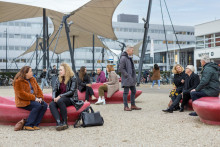 |
| Virginia Valian |
What will be the main message of your talk?
‘I'll be talking to a number of different groups at UT. For everyone, I want to stress the tendency towards evaluating a lower competence and ability level for women than for men, even when performance is equal, even when everyone sincerely intends to judge performance solely on the basis of merit, and even when women are doing the evaluating.’
What kind of ideas would you like to share with the UT community?
‘Most people in academic life are sincerely meritocratic. But it is difficult to live up to that goal without an understanding of cognitive processes that operate largely without our awareness. In order to buffer ourselves from these mistakes, we need to make different procedures at every level of the institution.’
The Female Faculty Network Twente (FFNT) suggests at least one female scientist should participate as an observer during application procedures and appointments. What do you think of this idea?
‘There is some evidence committees with women, especially committees chaired by women, lead to greater numbers of women being appointed. The mechanism probably works something like this, when the male members of a committee see a competent woman in their midst, they look at female candidates more positively or less negatively than they would otherwise. They are more inclined to see the genuine assets in a woman’s credentials. Since there are currently few women available to serve on such committees, and since service is time-consuming, a plan to increase the number of women should include release time from other duties.’
What can a governing board do to increase the number of woman at the most prominent levels of organizations?
‘Governing boards can do a great deal! I won’t speak specifically about UT’s executive board, since I expect to learn more about it during my visit. But, in general, governing boards can ensure a range of diversity efforts are put into action. There is evidence that the more different types of efforts an institution makes, the more likely it is to be successful, and visible decision-makers articulate concrete goals to increasing diversity and be accountable for achieving those goals. It all starts with data. What are the percentages of men and women at different ranks, salary, presence on important committees, and so on.
‘To increase diversity we all have to understand why diversity is good and how to make diversity work. A diverse group of people tends to come up with more innovative solutions to problems - if the group works. But diverse groups can fail if people do not appreciate what each member of the group has to offer.’
How do you look back at the impact of your book Why So Slow?
‘I have been very pleased with the response to Why So Slow? Its main impact has been to provide an intellectual basis, using data and theory from several fields, for thinking about gender within academic institutions. The book appeared at a time when there was renewed interest in having the composition of the scientific workforce represent the composition of the population as a whole.’
How would you qualify your contribution to the gender discussion?
‘Increasingly, though still less than I would like, people understand that knowledge of social science findings is crucial for devising good solutions. I think my book has contributed to further this understanding, but change is still too slow.’
What intrigues you the most about the gender discussion?
‘What intrigues me lies somewhat outside gender itself. I am intrigued by cross-national differences, such as Norway’s success in imposing a gender quota on business boards of directors in contrast to the US’s unwillingness even to have the word ‘quota’ mentioned in a discussion. I am intrigued by people’s misplaced confidence in the rationality of their judgments.’
What can we expect from you during the upcoming years?
‘My intellectual goal is to put together what we know about organizations, attitudes, and gender. I want to develop a new interdisciplinary field of gender equity that will integrate research on those three areas.’
How does your work week look like?
‘A typical work week involves teaching and research. This semester I am co-teaching an undergraduate Introduction to Psychology course with three colleagues to 500 students, last semester there were 850 students. I am also teaching a graduate course in Language Acquisition in the PhD Program in Linguistics at the City University of New York Graduate Center. Language acquisition - how very young children learn the structure of their language - is my specialty. My PhD students are studying language acquisition. In a few semesters I teach advanced undergraduate and graduate courses on the Social Cognition of Gender. My research is on language acquisition and on gender. Those two fields don’t overlap at all - in the way that I conduct them. I lecture outside the university about for to six times a semester and hold talks several times in the Netherlands at Groningen and Nijmegen, and in England, France, Germany, Norway, Japan, Korea, Italy, Canada. Sometimes I talk on language, sometimes on gender, sometimes on both.’
What is your own educational background?
‘My BA degree is from the University of Michigan at Ann Arbor, and my MA and PhD are from Northeastern University in Boston. All my degrees are in psychology. I knew I wanted to be a psychologist from the time I was 12 years old, though my specialty in psychology has changed.’
What do you do when you are not working?
‘I live in Manhattan, New York, and I love it. This week I saw the Mark Morris ballet company, which required a subway trip to Brooklyn. I also saw Sam Shepard’s A Lie of the Mind and I will see the New York City Ballet perform this week. New York’s cultural offerings are incredibly rich with opera, dance, music, theatre, art and restaurants. It’s wonderful. Simply walking down a street in Manhattan, almost any street, offers so much to see.’







